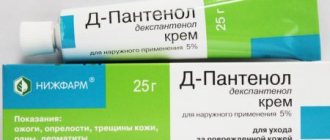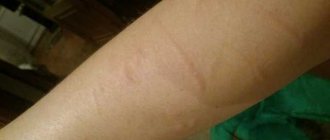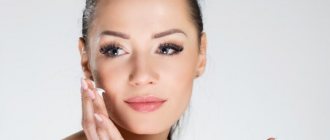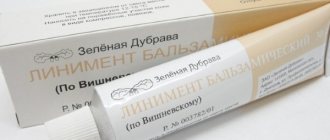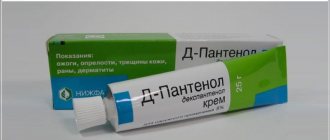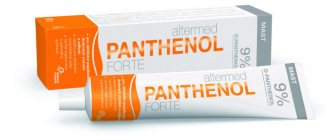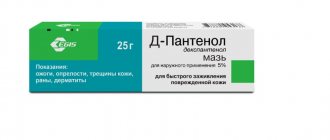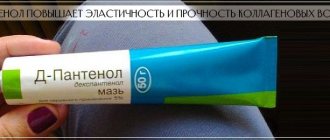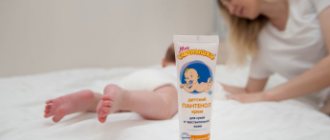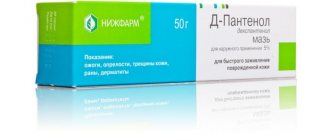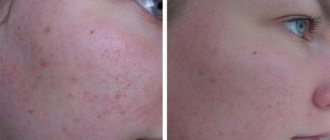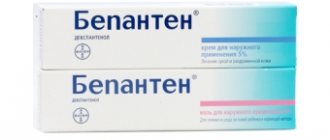D-panthenol is a unique means of restoring the skin after certain chemical, mechanical, and physical damage. It is actively used as a prophylactic drug to eliminate possible problems. Available in the form of ointment and cream. Both products have almost identical composition and therapeutic effect. But, the presence of additional ingredients provokes certain differences, which you definitely need to know about in order to make the right and competent choice.
Panthenol: cream, ointment and spray
Panthenol is a well-known wound healing agent that is produced by various pharmaceutical companies - in Germany, Serbia, Montenegro, and Russia. They all contain the same active ingredient and almost the same set of additional and form-forming components. Each of the Panthenols (De-Panthenol ointment, Panthenol-Ratiopharm, Panthenol-Teva ointment) has proven itself as an effective wound-healing drug.
The pharmaceutical industry offers several types of Panthenols. This can be an aerosol spray (foam from a can is the most popular version of the drug, and the most expensive). This may be an ointment or cream. Each of them has its own advantages.
Aerosol - allows you to apply the composition to the surface of the wound with a minimum number of touches . In addition, the composition itself is an airy, lightweight foam that does not block air exchange. Therefore, the spray is most widely used, especially in the treatment of burns (despite the fact that the price of an aerosol is three times higher than the cost of an ointment or cream).
As for the ointment composition, it is less popular and is used to treat various wounds (traumatic, surgical), as well as skin inflammations.
Panthenol ointment for children is also used for the treatment of dermatitis, diaper rash (Panthenol cream - for their prevention, prevention
).
What is the difference?
The main difference is in the form of release: ointment and cream. In the first case, lanolin, paraffin, and beeswax are used as additional components. In the second case, additional agents are ketomacrogol, cetearyl octanoate, propylene glycol, glyceryl.
The consistency of the ointment allows the components to quickly penetrate into the deep layers and bloodstream. Thanks to paraffin and wax, a kind of barrier-type film is created on the surface. Thanks to this form, a systemic effect of a therapeutic nature with a fairly deep effect is provoked.
The cream has a lighter structure due to the absence of wax and paraffin inclusions, as well as due to the presence of a significant amount of water in the composition. Thanks to this form, a local effect is provoked without penetrating into deeper layers. The cream is absorbed quickly and does not leave any greasy marks on the skin.
Once again about the choice of Panthenol: spray or ointment?
You can decide on any type of Panthenols (Teva, Ratiopharm or D-panthenol), cream or ointment - which is better, depending on the nature of the injury or the development of inflammation. The choice is determined by what exactly needs to be treated. Spray is much more expensive than ointment, so its use must be justified. The spray is used where it hurts to apply . Therefore, aerosols are used to treat any burns or large wounds.
Where it is easy to apply the drug (small wounds), or where it is necessary to cover the wound with a bandage, ointments are used.
Creams are compositions for rapid absorption and prevention. They are applied under the diaper (the ointment is too greasy for this) if there is no diaper rash yet. When diaper rash appears, they switch to ointment.
The cream is also applied to the face and hands to prevent them from drying out. Again, the choice between cream and ointment is determined by the type of skin. For oily skin, cream is necessary. For dry skin, you can use ointment.
Note: Panthenol ointment differs from a cream with a fatty base. It is absorbed for a long time, provides a long-lasting therapeutic effect, and remains on the surface of the skin for a long time.
Comparison of Panthenol and D Panthenol
Patients often ask what to choose, Panthenol or D Panthenol. The drugs have the same effect on the wound surface.
Similarities
The medications have a similar composition. Both drugs are available in the form of creams and ointments. They are safe for the body. Both drugs are allowed to be used during pregnancy. The drugs are approved for use in pediatrics.
What is the difference
The only difference is in the manufacturers. Panthenol is produced in Russia. Panthenol D is imported from Croatia.
Panthenol D is additionally available in the form of lozenges, which are prescribed to patients who have undergone surgery to remove the tonsils.
Panthenol in the form of a spray can be applied to the oral mucosa; its analogue does not have a spray form.
Which is cheaper?
Since Panthenol D is imported from other countries, its cost is much higher than the cost of the domestic drug. Both products can be freely purchased in pharmacies; a prescription is not needed in this case.
The cost of Panthenol D depends on the dosage. So, a 40 ml tube of cream costs about 77 rubles. Panthenol D 5% in the form of an ointment in a tube of 25 g costs 149 rubles.
The cost of Panthenol is also different:
- The price of the cream is 94 rubles.
- The cost of the ointment is 122 rubles.
- Baby cream – 295 rub.
Composition of the ointment
The main active ingredient in Panthenols is dexapanthenol . It is a provitamin, which, after absorption into cells, is converted into pantothenic acid. It ensures the occurrence of intracellular metabolic reactions.
By establishing metabolism, the acid stimulates the formation of new cells (accelerates their division) and thereby ensures rapid cell regeneration and skin restoration. Existing wounds and burns heal successfully, the skin is restored without scars or scars. In medical terminology, this is called epithelization, scarring of skin lesions.
The amount of active ingredient panthenol in the ointment is 5%. The cream also contains 5%. But in the spray - a little less - 4.6%. This means that each gram of the drug contains 5 mg (4.6 mg) of dexapanthenol .
Note: for any injury, the body needs an increased amount of pantothenic acid. Therefore, to accelerate wound healing, external and internal treatment are combined. Provitamin (pantothenic acid) is taken orally and, at the same time, an external ointment (or spray, cream) is applied. Also, taking dexapanthenol orally is necessary for internal injuries or after surgery (for rapid tissue restoration).
In addition to the main substance (dexapanthenol), the ointment contains formative components. Their set may vary, but, as a rule, all manufacturers contain lanolin, petroleum jelly, triglycerides and preservatives (potassium sorbate, sodium citrate, citric acid).
Pantothenic acid is non-toxic and non-carcinogenic. Therefore, cream with dexapanthenol is approved in pediatrics from the first days of life.
Characteristics of Panthenol
The main active ingredient of this drug is dexpanthenol. The medication is intended for external use only. Based on this, it is available in the form of cream, spray and ointment.
Release form:
- Panthenol ointment 5%. 1 g contains 50 mg of active substance. The rest consists of auxiliary components, such as lanolin, petroleum jelly, paraffin in liquid form.
- The consistency of the ointment is homogeneous, has a light yellow color, and a pleasant smell of lanolin. Packaged in tubes of 25 and 50 g.
- The cream also has a pleasant smell. But unlike ointment, it is white in color. The cream is supplied to pharmacies in tubes of 25 and 50 g.
- Spray Panthenol 4.6% Available in containers of 58 and 130 g.
The value of this drug is that it is able to accelerate the regeneration of the epithelium. Wounds heal faster due to the normalization of cellular metabolism and strengthening of collagen fibers. The drug has a slight anti-inflammatory effect.
The drug itself is a derivative of pantothenic acid. When a wound surface forms in the cells in this area, a deficiency of this acid occurs, which is eliminated by ointments, creams and aerosols.
The main advantage of the drug is that it is very quickly absorbed into the skin, turns into acid and binds plasma proteins.
The drug in any form is used to treat superficial wounds resulting from injuries and burns of various types. The product can be used to treat abrasions and scratches. In some cases, the product is used to treat dermatitis and diaper rash.
Panthenol spray penetrates deeper into the skin, and the healing effect occurs faster.
In nursing mothers, it is used to treat cracked nipples.
The cream can be used to prevent frostbite. The drug can also be used for more severe damage to the skin, for example in the treatment of bedsores.
Among all forms of medicine, the most effective is the spray. It penetrates deeper into the skin, and the healing effect occurs faster. Low temperature protection spray can be used daily.
Contraindications: allergic reactions to the components of the drug. Side effect: allergic skin rashes.
The drug can be applied to the wound surface 2 to 4 times a day. If the wound is infected, first apply an antiseptic and then Panthenol.
Panthenol ointment: instructions for use
Panthenol is a unique drug that should be kept in your home medicine cabinet at all times. They can be used to treat fresh and old wounds, the skin of infants and nursing mothers. Treat herpes and hemorrhoids with it. Use as a cosmetic cream (for face and hands).
Various ointments under the trade name Panthenol have almost the same composition and effect. Eg
, the main use of D-Panthenol ointment (Nizhpharm) and Panthenol Ratiopharm ointment according to the instructions sound the same. These are all types of skin wounds (cuts, burns, including sunburn, as well as cracks, postoperative wounds, transplants).
Let's list what Panthenol ointment is used for according to the instructions:
- Treatment of burns (any kind - sunburn, boiling water, chemicals).
- Dermatitis (allergic redness and peeling of the skin) - the application of panthenol prevents infection of flaky areas, and also reduces itching and pain.
- Diaper rash and bedsores are inflammations of the skin in infants and the elderly.
- Treatment of cracked nipples in nursing women . Before feeding, remove any remaining ointment and wash the breasts with warm water. Getting the ointment into the baby's mouth is not dangerous, but may create discomfort during feeding. It will be uncomfortable for the baby to grasp the slippery nipple. Therefore, the breasts should be clean and dry.
- Protecting the face and hands from chapping and frosty peeling (relevant for dry skin types, and using ointment is effective).
- Trophic ulcers, deep wounds.
Important: Panthenol ointment should not be applied to weeping skin inflammations (eczema).
Is the texture of both of these drugs the same?
The composition of the drugs we are considering today is the same, and precisely for this reason, there is nothing strange in the fact that in the vast majority of cases, they exhibit identical effects on the human body, skin, and so on. At the same time, some categories of the modern population note that Panthenol is somewhat greasy and, among other things, is absorbed much worse than D Panthenol. Of course, this is a subjective opinion that directly depends on your skin type and other equally important aspects. Therefore, there is even a certain probability that in your case, it is not Panthenol that will seem greasy, but D Panthenol!
Panthenol ointment for burns
The most popular use of Panthenol is for burns. (aerosol spray) are used to treat wounds.
. Foam must be applied in the first days after thermal injury. The spray is sprayed over the surface of the wound with minimal painful touches.
Panthenol ointment is used when it is necessary to apply a bandage . In this case, an ointment composition is generously applied to the surface of the wound and covered with a sterile cloth.
Dexapanthenol is effective for treating any burns - solar, thermal (boiling water), chemical, electrical. For the effect of the ointment, it does not matter how the injury was caused. It is important that the components of the ointment stimulate the formation of new epidermal cells and treat existing inflammation.
Indications
According to the instructions, the indications for using Panthenol as a medicine are wounds, burns and other violations of the integrity of the skin. For cosmetic purposes, the drug is used much more widely, for example, to solve such problems:
- dryness and flaking of the skin;
- decrease in her turgor;
- signs of photoaging;
- inflamed acne;
- acne;
- various types of dermatitis.
Panthenol spray or ointment is also recommended for use in the first days after laser or chemical peels, microdermabrasion, manual facial cleansing, mesotherapy, and hardware hair removal. The drug accelerates wound healing and prevents the development of inflammatory processes.
Panthenol ointment for acne
Since dexapanthenol has an anti-inflammatory effect, it is used to combat pimples, blackheads and other skin inflammations. However, the effect of the ointment is average . This is explained by the slight anti-inflammatory properties of dexapanthenol.
Note: the ointment composition is not suitable for treating oily skin, so it is not used to treat acne. You can use Panthenol to treat and rejuvenate dry and normal facial skin.
Tattoo healing ointment
A real tattoo involves trauma to the skin. As a result, inflammation is formed. The use of wound healing ointment is necessary in the first 3-4 days after tattooing .
The healing of tattoos is almost always accompanied by itching, burning, and pain. Especially during the first day and a half. Therefore, you can’t do without dexapanthenol here.
Panthenol ointment will promote the formation of new skin and treat inflammation. Before applying the ointment, the tattoo site is treated with an antiseptic (for example, chlorhexidine, miramistin
).
Important: the tattoo should not dry out until it is completely healed; the ointment composition will help with this.
Contraindications and side effects
There are no contraindications to pure panthenol. It cannot cause harm even with open wounds or during pregnancy. But this cannot be said about all its analogues, which contain other biologically active components.
With prolonged use, ointments can clog pores, since it has a fairly dense base. Therefore, before each new application, you should wash your face well. And after completing the course of treatment, it is useful to do ultrasonic cleaning or superficial acid peeling, if there are no contraindications to these procedures.
In rare cases, individual intolerance to panthenol occurs, especially if a 7 percent spray is used. It is worth trying to replace it with a cream or ointment with a lower concentration of pantothenic acid. If itching and burning remain after application, you will have to look for other regenerating agents.
Panthenol ointment: analogues
Analogues of Panthenol are drugs that contain the same active substance (dexamethasone). The previously listed products called D-Panthenol or Ratiopharm, Teva are analogues of each other
. They are so similar that it is difficult to choose the best one. Therefore, the main criterion becomes the price of an aerosol, cream or ointment.
Let's name other drugs that also contain dexamethosone:
- German Bepanten (manufacturer - pharmaceutical company Bayer). Bepanten is often compared with D-Panthenol, which is better and which is more effective, is it worth paying more for a more expensive drug? D-Panthenol is a cure for Russian. It is cheaper than its German “brother” by a third. At the same time, it is quite effective and of high quality (with one but - if the drug is really produced by the pharmaceutical company Nizhpharm, and is not a fake). There is one more caveat - for children with a developed allergic reaction, it is better to use a German drug . It contains fewer unnatural components that can cause an atypical reaction.
- Russian Pantoderm (pharmaceutical company Akrikhin) - contains the same 5% dexapanthenol. In addition to other components, the composition contains almond oil. Pantoderm is sold at an affordable price.
- Korneregel is a gel form of the drug with dexamethasone for the treatment of eyes .
Let's get to know each other better
"Panthenol" is sold in pharmacies and is a medicinal product. But cosmetologists often use it in their work and recommend it to clients as a means of intensive skin care and restoration.
It is produced in Germany by the pharmacological concern Dr. Gerhard Mann and is not cheap. But you can also buy analogues at a budget price.
Release form
The original drug with a patented trademark is available in several forms:
- Ointment. It has an oily base and is ideal for dry, flaky skin, which it softens perfectly. It is also used for burns, as it creates an occlusion effect and promotes deep tissue hydration.
- Cream. It also has a fatty component, but is a lighter emulsion. This is a universal drug suitable for any skin type and condition. It can be used in its pure form or become the basis for anti-aging and anti-inflammatory masks.
- Spray. I recommend using it as an emergency remedy. Does not contain fat, is quickly absorbed and causes cells to actively regenerate. The canister contains an aerosol. When you press the cap, a fairly dense foam comes out of it, which gradually dissolves.
In the original preparation there is no difference in the content of panthenol - in any form its concentration is 5 percent. But in analogues it can be smaller or larger.
Methods of application
The use of panthenol as a cosmetic product is possible in various ways:
- In its purest form. Apply to irritated, inflamed or damaged skin two to 4-5 times a day.
- Like anti-wrinkle masks. In this case, you need to choose a cream, not an ointment, which, if used regularly, will clog the pores. You can add a multivitamin complex or some natural oils to it for very dry skin.
- Against acne and pimples. It is better to first treat problematic and inflamed skin with chlorhexidine or another antiseptic. And add 2-3 drops of essential oil with antibacterial or antifungal properties to the cream: eucalyptus, tea tree, etc.
You should smear your face after preliminary thorough cleansing and do not apply decorative cosmetics on top of panthenol.
An overdose of this drug is impossible. However, you should not use it for a long time. Even for rejuvenating purposes, a two-week course is quite enough. And then in preventive measures - 4-8 times a month.
Analogues of "Panthenol"
Of course, as a cosmetologist, I always advise buying original products. As a rule, they work better and are guaranteed to give the effect declared by the manufacturer. But they are usually expensive, especially imported ones. That's why people often buy analogues. Fortunately, Panthenol has them and they are of quite high quality.
Among the most famous:
- Ointment "Bepanten". It copes well with diaper rash and diaper dermatitis, and easily relieves all irritations. It also contains lanolin, which softens the skin, and beeswax, which creates a thin protective barrier. Accordingly, it is contraindicated for people with allergies to bee products.
- Cream "Pantekrem". Also contains lanolin, but without wax. The product is universal, hypoallergenic, and has a reasonable cost. The composition contains ceramides that quickly restore the damaged structure of the epidermis.
- Gel "Pantestin-Darnitsa". An excellent product for problem skin, which contains a substance with powerful antibacterial and anti-inflammatory properties, miramistin. Suitable for acne, inflamed acne, wounds and ulcers.
The list is far from complete. When purchasing, you must carefully study the instructions, and first of all the section with contraindications. If in doubt, it is better to consult a pharmacist or still purchase the original drug.
Reviews
Nadezhda, 36 years old, Saratov
I am treating herpes with Panthenol. If you apply it right away, when it just starts to hurt (there is no rash yet), then the cream will dry out and there won’t be a big rash. Checked several times already.
Larisa, Nizhny Novgorod I tried Panthenol Teva for wrinkles - it didn’t help much.
Elena, 30 years old, Armavir Panthenol Teva - ointment for wounds and burns. Why should she remove wrinkles? Well, it will make your skin fresher. If you want to be younger, smile more often, the skin on your face will tighten, and if there are any wrinkles, they will be nice.
